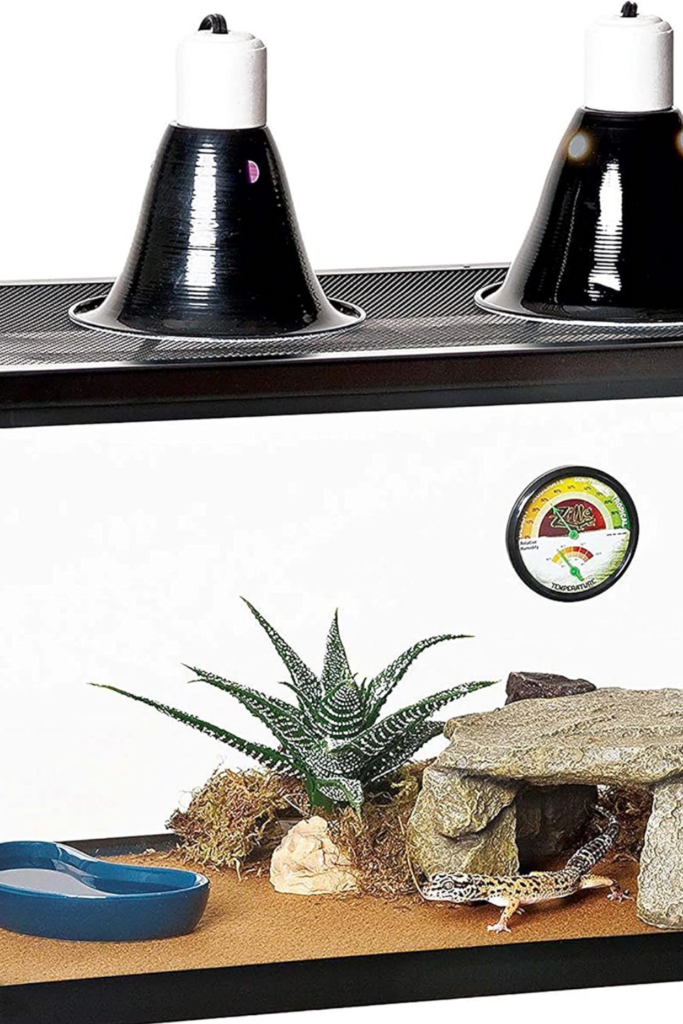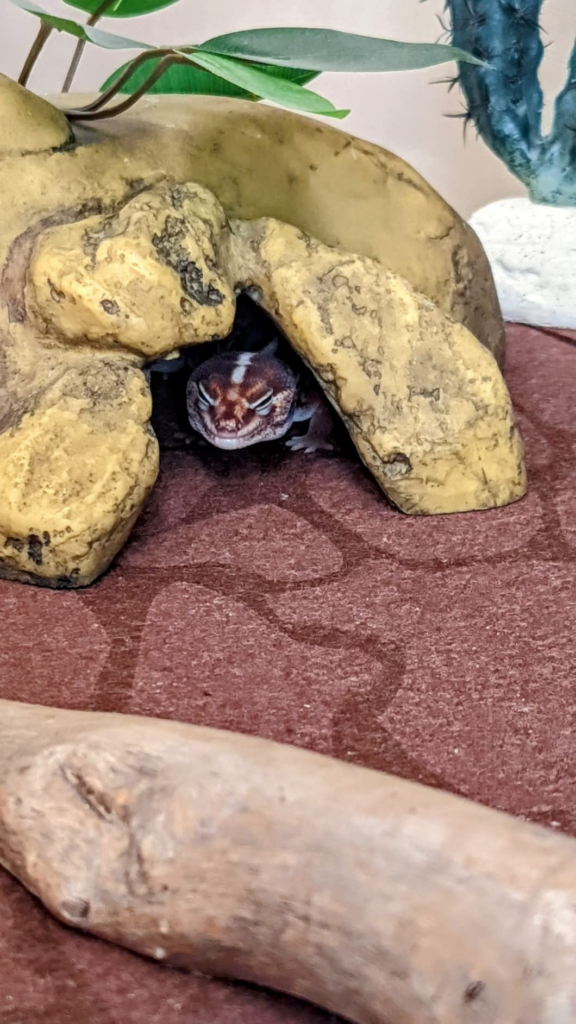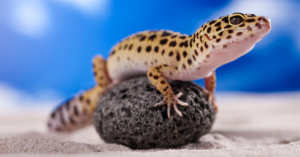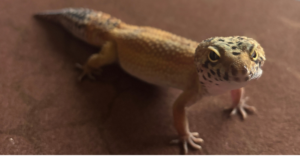
Why a Proper Leopard Gecko Habitat Setup Matters
Out in the wild, leopard geckos are masters of survival. They thrive in the rocky deserts of Afghanistan, Pakistan, and India, slipping between crevices, soaking up the last traces of heat from sunbaked stone, and burrowing deep to escape the cold. In captivity, they depend entirely on you to replicate this delicate balance.
A poorly designed enclosure isn’t just uncomfortable—it’s dangerous. Too dry, and shedding becomes a nightmare, leaving layers of stuck skin that can cut off circulation. The wrong substrate? That could mean impaction, a silent killer that stops digestion. A tank placed under direct sunlight? You’re playing with fire—literally.
Every choice matters. The right heating system mimics the warmth of sun-soaked rocks, the proper humidity prevents stuck sheds, and a well-placed hide offers security from perceived predators. This isn’t just about making your gecko comfortable—it’s about keeping them alive.
Now, let’s break it down, starting with the foundation of every successful setup—the tank itself.

Step-by-Step Leopard Gecko Habitat Setup for First-Time Owners
Before you bring home your leopard gecko, you must build a home that mirrors its natural environment. The right enclosure isn’t just about size—it’s about function. Leopard geckos are ground-dwelling creatures that need floor space, not height. Those tall, narrow setups designed for tree-dwelling reptiles? Useless. Instead, you need a tank with enough length and width to allow for natural movement, exploration, and thermoregulation.
A 20-gallon tank is the gold standard for a single adult gecko. However, bigger is always better. Glass terrariums are the go-to for visibility and durability, but PVC or wooden enclosures work well if you’re aiming for superior heat retention. Whatever you choose, ventilation is key—stagnant air leads to moisture buildup, and that’s a breeding ground for bacteria and respiratory infections.
Placement matters, too. Keep the enclosure away from direct sunlight, drafts, and high-traffic areas. A stressed gecko will refuse to eat, stay hidden, and ultimately struggle to thrive. You’re creating a slice of the leopard gecko’s natural world inside your home—set it up wisely, and you’ll have a reptile that moves, eats, and behaves like the predator it was born to be.
Now, let’s talk about the most important factor in your gecko’s health: heating.

Mastering Leopard Gecko Heating and Lighting
In the wild, leopard geckos soak up heat from sun-warmed rocks during the day and retreat to cooler burrows at night. They rely on external warmth to digest food, stay active, and maintain their immune system. If you get heating wrong, your gecko’s system goes out of balance.
Here’s the deal—leopard geckos don’t bask like bearded dragons. They absorb heat from below, so many keepers turn to under-tank heating pads. But relying on belly heat alone isn’t enough. The best approach? A combination of an overhead heating source—like a halogen bulb or deep heat projector—and an under-tank heater for consistent warmth.
You aim to create a gradient—a warm side and a cool side. One end of the enclosure should sit between 90-92°F, while the cooler side stays around 75°F. At night, temperatures can drop slightly, but never below 60°F. Use digital thermometers on both ends and a thermostat to regulate everything. And ditch the heat rocks—those things are notorious for causing burns.
And what about light? Technically, leopard geckos don’t need UVB to survive, but research shows they thrive with it. A low-output UVB bulb, like the Arcadia ShadeDweller, can help with calcium absorption and boost overall health. Just make sure they have shaded areas to escape the light when needed.
Now that your gecko has the perfect heat gradient, it’s time to focus on the substrate beneath their feet.
The Truth About Leopard Gecko Substrates: Safe vs. Deadly Choices
Walk into any pet store, and you’ll see rows of reptile bedding labeled “desert sand” or “calcium sand,” marketed as the “natural choice” for leopard geckos. But here’s the cold, hard truth—loose sand is one of the leading causes of impaction, a deadly condition where ingested particles block the digestive system. A bad substrate choice can mean the difference between a thriving gecko and one that struggles to survive.
So, what should you use? For beginners, simplicity is key. Paper towels may not be glamorous, but they’re cheap, easy to clean, and completely safe. Unprinted butcher paper works the same way. If you want a more natural look, slate tile is an excellent option—it retains heat well, provides traction, and looks great in any enclosure.
For experienced keepers, bioactive substrates can mimic a gecko’s natural habitat. Mixing organic topsoil, play sand (60/40 ratio), and clay creates a solid, diggable surface while reducing impaction risk. If you go this route, introduce a cleanup crew of isopods and springtails to break down waste and keep the environment fresh.

The key is to balance safety with function. Leopard geckos aren’t burrowing deep into loose sand in the wild—they’re navigating rocky terrain, dry soil, and compacted dirt. The right substrate keeps them healthy, active, and moving naturally.
Now, let’s talk about the final puzzle piece—accessories.
Essential Accessories for a Leopard Gecko’s Habitat
A leopard gecko without the right accessories is like a predator without cover—exposed, vulnerable, and stressed. In the wild, these reptiles slip into crevices, burrow under rocks, and seek out microclimates to regulate their body temperature. You must provide those same options in captivity, or your gecko will suffer.
First, let’s talk hides. At a minimum, you need three: one on the warm side, one on the cool side, and one on the humid hide. The warm hide is your gecko’s go-to spot for digesting meals. The cool hide is a retreat from heat. And the humid hide? That’s a game-changer for shedding—line it with moist sphagnum moss to prevent stuck shed, especially around the toes and tail.
Water and food dishes are simple but crucial accessories. A shallow water dish should always be available, but make sure it’s not too deep—geckos aren’t swimmers. A feeding dish helps contain mealworms and keeps the enclosure clean.
Now, let’s talk enrichment. Climbing rocks, branches, and fake plants aren’t just decorations—they make the enclosure feel natural and give your gecko a reason to explore. Just make sure everything is stable—geckos may not be climbers like chameleons, but they’ll still test their environment.
Every accessory in the setup serves a purpose: helping your gecko feel secure, stay hydrated, and move as naturally as possible. Keeping the habitat clean is the only thing left with the habitat fully set up.
Building Confidence in Your Leopard Gecko Habitat Setup
When everything is set up correctly, your leopard gecko will tell you. A thriving gecko moves purposefully—exploring, hunting, and using every inch of the enclosure. They’ll shed cleanly, eat regularly, and stay alert. On the other hand, a stressed gecko hides excessively, refuses food, or shows signs of distress like glass-surfing or lethargy.
If your gecko isn’t thriving, don’t panic—adjustments are part of the process. Check the heating gradient. Ensure the substrate is safe. Confirm humidity levels with a hygrometer. Small changes can make a huge difference in their comfort and overall health.
The best part? You can enjoy watching them thrive once you’ve dialed in their environment. There’s nothing like seeing a leopard gecko confidently stalk prey, relax in a well-placed hide, or emerge from a shed looking flawless. You’ve taken a creature from the wild and given it a tank where it can live, grow, and behave naturally. That’s the mark of a responsible reptile keeper.
This journey doesn’t end here. Keep learning, refining, and improving your gecko’s home. The more you understand their natural behaviors and needs, the better you’ll be at providing the ideal environment. And in return? You’ll have a healthy, active gecko that lives for years—maybe even decades.
If you’re ready to take your gecko’s habitat to the next level, consider upgrading your accessories for even more enrichment. The adventure of reptile keeping is never over—it just evolves.
Affiliate Disclosure
This article contains affiliate links from the Amazon Associates Program and other affiliate networks. If you purchase through these links, I may earn a small commission at no extra cost. These commissions help support the site and allow me to continue providing valuable content on leopard gecko care. I only recommend products that I believe are high quality and beneficial for pet owners.


